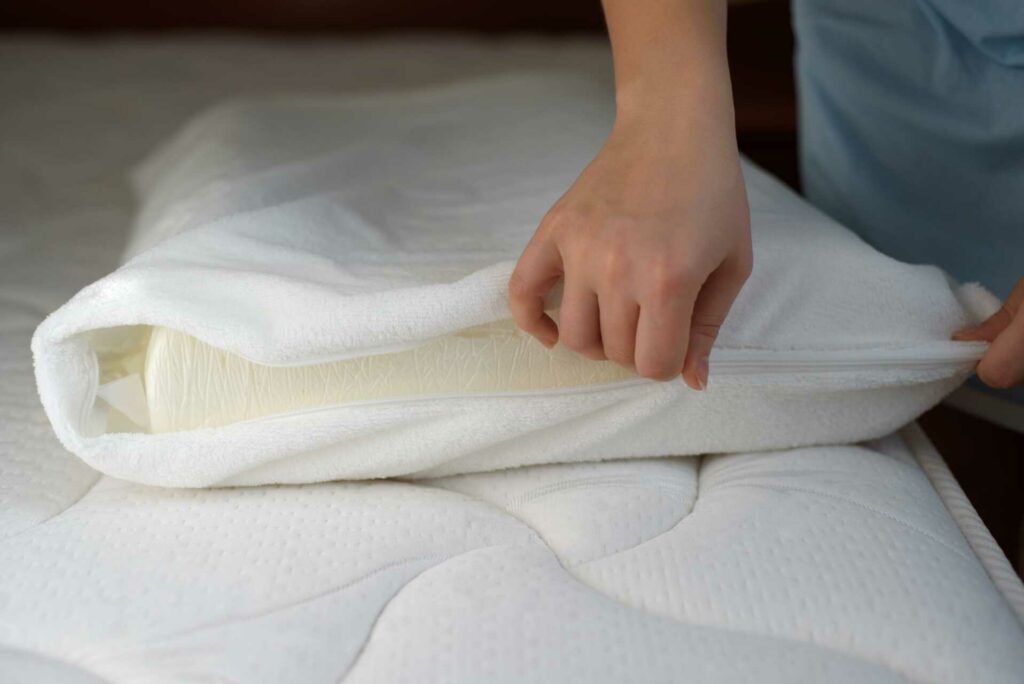
Contents
Check for stains, shed skins, or bites to keep bed bugs away. Declutter often and vacuum well. Seal gaps with caulking and weather stripping. Wash bedding and vacuum furniture regularly. Try traps for early detection. More tips await to help you safeguard your space.
Key Takeaways
- Regularly inspect bedding and furniture for signs of bed bugs.
- Declutter living spaces to reduce hiding spots for bed bugs.
- Seal entry points with weather stripping and caulk to prevent infestations.
- Launder and vacuum bedding frequently to deter bed bugs.
- Use bed bug traps near sleeping areas for early detection.
Identifying Bed Bug Signs
To spot bed bug signs early, inspect your bedding and furniture regularly for small reddish-brown stains or shed skins. Early detection is key to preventing a full-blown infestation. Keep an eye out for tiny black dots, which are bed bug feces, on your sheets or mattress. If you wake up with unexplained bites or rashes, it’s essential to investigate further. These signs indicate the presence of bed bugs in your living space.
While DIY inspections are useful, sometimes you may need a professional inspection to confirm the infestation. Professional inspection provides a thorough assessment of the situation and can help determine the extent of the bed bug problem. If you suspect bed bugs but are unsure, it’s best to seek the expertise of a pest control professional. They have the knowledge and tools to identify bed bugs accurately and recommend the appropriate course of action.
Decluttering Your Living Space
Keeping your living space clutter-free is essential for effective bed bug prevention. Clutter provides hiding spots for bed bugs, making it harder to spot an infestation early. To maintain a tidy living space, consider implementing some organizing tips and storage solutions.
Start by decluttering regularly and getting rid of items you no longer need. Donate or sell things that are in good condition but no longer serve you to create more space in your home.
Invest in storage solutions such as under-bed storage containers or closet organizers to help keep your belongings organized and off the floor. This makes it easier to spot any potential bed bugs and reduces hiding spots for them. Vacuum regularly, paying special attention to areas where clutter tends to accumulate, like under the bed or in closets.
Consider using furniture with minimal gaps and crevices where bed bugs can hide. Opt for sleek, modern designs that are easier to inspect and clean. By keeping your living space clutter-free and well-organized, you’re taking proactive steps towards preventing bed bug infestations.
Sealing Entry Points
Maintaining a clutter-free living space can greatly help in preventing bed bugs; now, shift your focus to sealing entry points to fortify your defense against these pests. Keeping these critters out is essential in protecting your sanctuary.
Here are three simple yet effective ways to seal entry points and keep those bed bugs at bay:
Weather Stripping: Check doors and windows for any gaps where bed bugs could sneak in. Applying weather stripping along the edges can create a tight seal, making it more challenging for these unwelcome guests to find their way inside.
Caulking Gaps: Inspect walls, baseboards, and any cracks or crevices in your home. Use a caulking gun to seal up these gaps, as bed bugs can easily hide in these tiny openings. By caulking these areas, you create a barrier that deters bed bugs from entering.
Regular Maintenance: Stay vigilant and perform routine checks around your home. Replace any worn-out weather stripping, reapply caulking as needed, and address any new gaps promptly. Consistent maintenance is key to ensuring your home remains a bed bug-free zone.
Laundering and Vacuuming Practices
Regularly washing and vacuuming your bedding and furniture is vital in eliminating and preventing bed bugs from infesting your living space. Bed bugs are notorious for hiding in cracks and crevices, making it essential to maintain a clean environment to deter them. To enhance your prevention efforts, consider using mattress encasements to seal off these pests from making a home in your bed. These encasements act as a barrier that prevents bed bugs from entering or escaping, ultimately protecting your mattress from infestation.
In addition to washing your bedding, steam cleaning your mattress and upholstery can effectively kill bed bugs and their eggs. The high temperatures of steam are lethal to bed bugs, providing a chemical-free method to eradicate them. Incorporating essential oils such as lavender or tea tree oil into your cleaning routine can also act as a natural repellent against bed bugs due to their strong scents that deter these pests. Moreover, silica gel can be sprinkled around your bed frame and furniture legs to create a barrier that dehydrates and kills bed bugs upon contact.
Using Bed Bug Traps
Consider strategically placing bed bug traps around your bed and furniture to monitor and capture any unwanted pests. Here are three simple ways bed bug traps can help you in your pest control efforts:
Early Detection: By placing bed bug traps near your bed and other furniture, you can quickly catch any signs of a bed bug infestation. These traps act as an early warning system, alerting you to the presence of bed bugs before they have a chance to multiply and spread throughout your home.
Monitoring: Bed bug traps allow you to monitor the effectiveness of your pest control efforts. By regularly checking the traps for any captured bed bugs, you can gauge whether your home remedies are working or if you need to take additional steps to eradicate the pests.
Peace of Mind: Knowing that you have bed bug traps in place can provide you with peace of mind. Instead of constantly worrying about a potential infestation, you can rest easy knowing that you’re actively taking steps to control and prevent bed bugs in your home.
Incorporating bed bug traps into your pest control routine can be a simple yet effective way to protect your home from these unwanted intruders. By using these traps in conjunction with other home remedies, you can create a holistic strategy to keep your living space bed bug-free.
Summary
Now that you’ve armed yourself with these DIY bed bug prevention tips, you can sleep tight knowing you’ve taken steps to keep those pesky critters at bay.
Remember, prevention is the key to keeping your sanctuary bug-free. By staying vigilant and implementing these simple strategies, you’ll be able to rest easy and enjoy a peaceful night’s sleep without any unwelcome visitors crawling around.
So go ahead, tuck yourself in, and dream sweet dreams, bug-free!
Recent Posts
Ultimate Guide to Pest Eradication Solutions in West Michigan
Imagine a garden overrun by persistent weeds that refuse to budge despite all your efforts.
3 Best Pest Eradication Solutions in West Michigan
When it comes to dealing with pesky critters in West Michigan, you want effective solutions
Effective Pest Eradication Solutions in West Michigan
When it comes to addressing pest issues in West Michigan, you’ll find a myriad of
